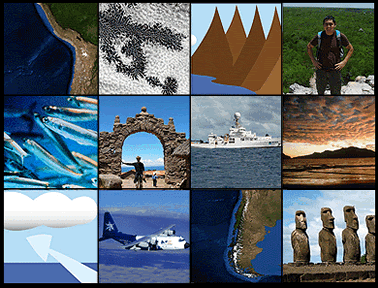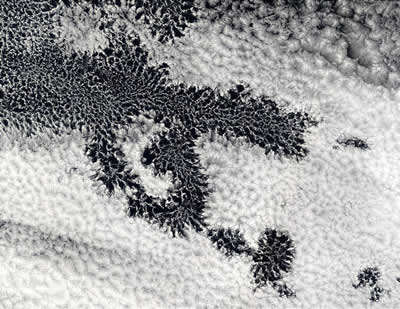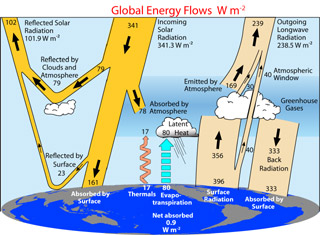Satellite images like this one help scientist on the VOCALS campaign. This picture shows patterns in clouds over the Southeastern Pacific Ocean.
Click on image for full size
Image Courtesy of the MODIS Science Team at NASA GSFC
Satellites in the VOCALS Field Campaign
Scientists use lots of data from satellites in the VOCALS field campaign. They also gather data from instruments on ships and on airplanes. When they combine data from satellites, ships, and aircraft, they get a better "picture" of what's going on in the Southeast Pacific.
Satellites give VOCALS scientists lots of data about clouds and the atmosphere. Pictures from satellites show scientist where there are clouds and where the air is clear. They also measure how much sunlight is reflected from clouds back into space. Instruments on satellites also help scientists measure the wind, spot swarms of tiny aerosol particles, and figure out what water droplets in clouds are like.
Satellites also help measure things about the ocean. They tell us the temperature of the ocean, what ocean currents are like, the height of the sea surface, and even where there is lots of plankton. Scientists combine these satellite measurements with data gathered from ships.
Which satellites are used by VOCALS? There are a lot of them! Here are the main ones. They include NASA's Terra, Aqua, CloudSat, and QuikSCAT. There is also the Tropical Rainfall Measuring Mission (TRMM) satellite, which is from NASA and JAXA (Japan Aerospace Exploration Agency). The GOES-10 satellite is from NOAA (National Oceanic and Atmospheric Administration). GOES stands for Geostationary Operational Environmental Satellite.
You might also be interested in:

What if you wanted to learn more about the climate of a very large area of the world? What would be involved in studying how the oceans, land, and atmosphere interact? You would need to have a team of
...more
Stratocumulus clouds are commonly found over the ocean in the Southeast Pacific region. These clouds can contain clear areas in the clouds that scientists call "pockets of open cells," or POCs.
...more
Light from the Sun shines on Earth. Some of that light reflects off clouds back into space. Some of the light makes it to the ground and warms our planet. The warm ground and oceans give off infrared (IR)
...more
Wind is moving air. Warm air rises, and cool air comes in to take its place. This movement creates different pressures in the atmosphere which creates the winds around the globe. Since the Earth spins,
...more
When you look up at the sky, you are looking at more than just air. There are also billions of tiny bits of solid and liquid floating in the atmosphere. Those tiny floating particles are called aerosols
...more
The water at the ocean surface is moved primarily by winds that blow in certain patterns because of the Earth’s spin and the Coriolis Effect. Winds are able to move the top 400 meters of the ocean creating
...more
Scientists use lots of data from satellites in the VOCALS field campaign. They also gather data from instruments on ships and on airplanes. When they combine data from satellites, ships, and aircraft,
...more













